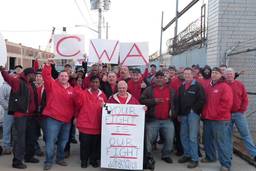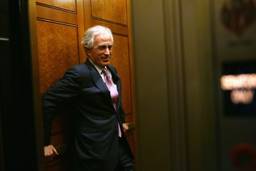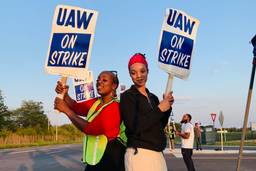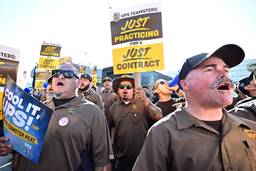After a nearly 13-year struggle, yesterday 282 Cablevision workers based in Brooklyn voted to join the Communication Workers of America by a margin of 180-86. The workers had previously attempted to organize on a number of occasions with both CWA and the electrical workers (IBEW) union, but each time were defeated. But by using a smart campaign strategy of building a strong shop floor committee, combined with support from public officials and the general public, this time CWA was successful.
The victory creates a toehold in the cable TV industry, which is traditionally nonunionized. While the telecommunication industry is nearly 90 percent unionized, according to CWA only 2 to 4 percent of cable TV workers are unionized, and Cablevision workers make one-third less than CWA-represented Verizon workers holding similar jobs.
“I’ve waited 13 years for this,” Cablevision technician Clarence Adams said. “United … we now have the power to negotiate a fair contract that will give us the dignity and respect on the job we deserve.”
In order to join a union, Cablevisions workers had to overcome the company’s anti-union campaign. They were made to attend anti-union meetings and attend intimidating one-on-one meetings with their supervisors about the merits of joining a union, CWA officials said. Cablevision also employed the famous unionbusting law firm Jackson Lewis to help delay the election in order to have more time to intimidate workers and hold captive audience anti-union meetings.
“Over the past few months, these courageous workers withstood a blistering assault on their right to form a union,” said Chris Shelton, CWA District 1 vice president. “Cablevision truly took the low road by pressuring workers with endless amounts misinformation, but these workers – backed by countless community leaders and elected officials – stood strong.”
When faced with employer anti-union campaigns, unions like CWA rarely win such lopsided victories — this one had a nearly 3-to-1 margin of victory — in the private sector.
Typically, when unions hold one-on-one meetings to intimidate workers out of joining unions, it creates a culture of fear where workers worry about being seen as organizing on behalf of the union. This type of fear can be difficult for workers to overcome unless they feel a strong sense of support. In the Cablevision organizing drive, CWA organizers focused first on building a strong shop floor committee of workers who wanted to join the union; the union collected pro-union cards from 70 percent of workers before even filing for an NLRB union representation election.
After building that support, the union sought to build public support in order to draw attention to the workers’ cause and protect workers from illegal firings that often occur during union organizing drives. While Cablevision preferred to present the merits of voting against CWA union representation in captive audience meetings with workers, New York City Public Advocate Bill de Blasio, who is considering running for New York City Mayor in 2013, offered to moderate a debate on the merits of unionizing between Cablevision CEO James Dolan and CWA Local 1109 President Rolando Scott.
Additionally, prominent elected officials including several U.S. Representatives, the New York State Democratic Leader John Sampson, the New York City Council Speaker Christine Quinn and New York City Council Speaker Christine Quinn wrote a letter to Dolan demanding that the company stop its anti-union practices and agree to a debate. The pressure of public officials was important because in addition to owning Cablevision, Dolan owns Madison Square Garden and the New York Knicks — businesses that by their nature have a lot of interactions dealings with public officials.
The union was also able to gain the support of the general public for an organizing drive by running public media blitz campaign that attracted an unusual amount of media attention for a group of only 282 workers. Articles appeared in The New York Times and other media outlets. CWA set up a website calling attention to the anti-union campaign of Cablevision and took out web ads to attract people to the cause of Cablevision workers attempting to organize.
According to Matt Tepper of the public relations firm Berlin Rosen, which assisted the union, “CWA place ads on NY political sites like New York Observer, Daily Politics, and Capital New York – as well as on the Google Ad Network targeting not only labor and news sites, but industry sites like dslreports.com and Slashdot.com. We also had ads up on YouTube.”
The web ads and PR blitz helped generate an unusual level of public media attention to the workers. This helped make it difficult for Cablevision to engage in extreme acts of unionbusting like firing workers.
“We wanted to start signaling to Cablevision that this is going to be unlike any other campaign that they have ever seen. We are seeking to organize not just these workers, but 1,500 Cablevisions workers through the Tri State area and we want Cablevision to change their anti-union behavior,” CWA organizer Tim Dubnau says. “By putting the public spotlight on them, we are hoping to be able to make Cablevision go down a few notches from a 10 to an 8 in their anti-union activity.”
By using a combination of old-school shop floor organizing, strong support from elected officials and a traditional public relations and new media blitz, CWA proved that while organizing in the private sector can often be difficult, if done with a smart strategy unions can overcome employers’ anti-union campaigns.

I hope you found this article important. Before you leave, I want to ask you to consider supporting our work with a donation. In These Times needs readers like you to help sustain our mission. We don’t depend on—or want—corporate advertising or deep-pocketed billionaires to fund our journalism. We’re supported by you, the reader, so we can focus on covering the issues that matter most to the progressive movement without fear or compromise.
Our work isn’t hidden behind a paywall because of people like you who support our journalism. We want to keep it that way. If you value the work we do and the movements we cover, please consider donating to In These Times.







